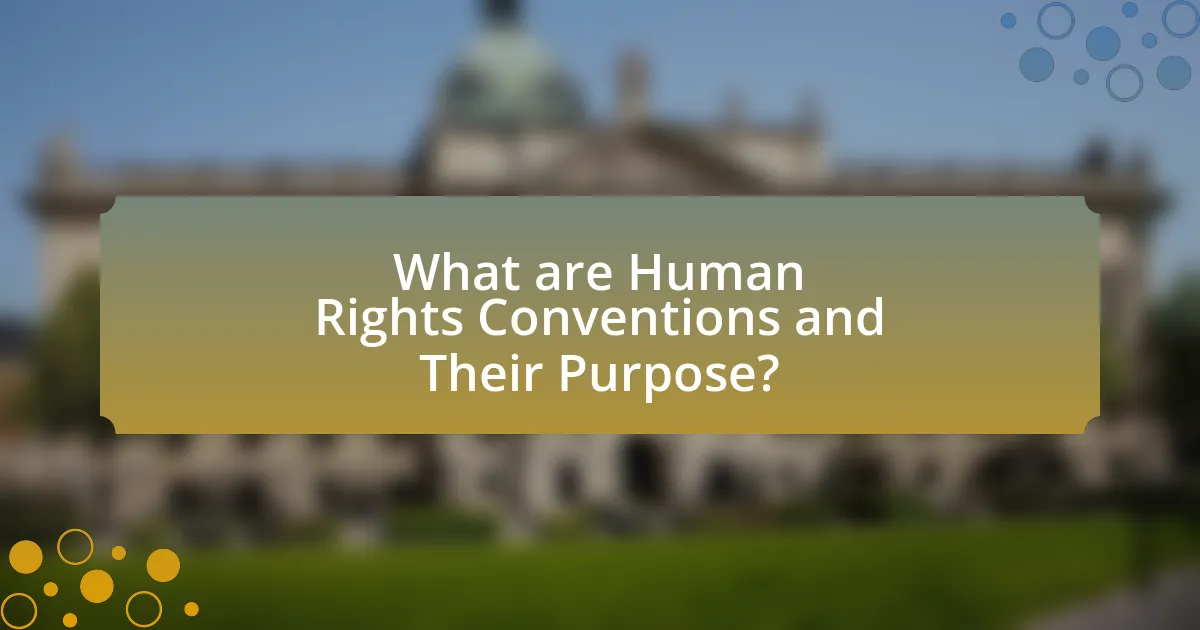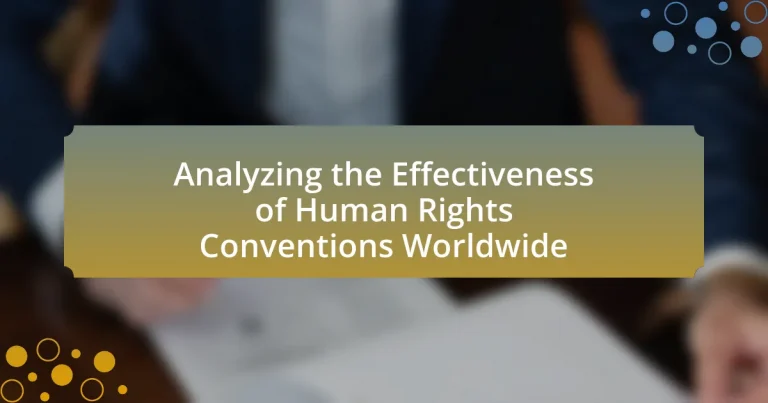Human rights conventions are legally binding agreements between states that establish standards for the protection and promotion of fundamental rights and freedoms. This article analyzes the effectiveness of these conventions worldwide, highlighting their purpose, key principles, and the differences from other international agreements. It discusses major conventions such as the Universal Declaration of Human Rights, the challenges faced in implementation, and the role of monitoring bodies and NGOs in promoting compliance. Additionally, the article examines the impact of these conventions on societies, particularly regarding social justice and the rights of marginalized groups, while also addressing the metrics used to assess their effectiveness and the consequences of non-compliance.

What are Human Rights Conventions and Their Purpose?
Human rights conventions are legally binding agreements between states that establish standards for the protection and promotion of human rights. Their primary purpose is to ensure that individuals are afforded fundamental rights and freedoms, such as the right to life, freedom from torture, and the right to a fair trial. For example, the Universal Declaration of Human Rights, adopted by the United Nations in 1948, serves as a foundational document that outlines these rights and has influenced numerous international treaties and national laws. These conventions aim to hold governments accountable for human rights violations and promote a universal standard of human dignity.
How do Human Rights Conventions differ from other international agreements?
Human Rights Conventions differ from other international agreements primarily in their focus on the protection and promotion of individual rights and freedoms. Unlike treaties that may address trade, environmental issues, or military alliances, Human Rights Conventions specifically aim to establish standards for the treatment of individuals and to hold states accountable for violations. For instance, the Universal Declaration of Human Rights, adopted in 1948, sets forth fundamental human rights that are universally applicable, emphasizing dignity, equality, and respect for all individuals, which is distinct from the objectives of other international agreements that may prioritize state interests or economic benefits.
What are the key principles underlying Human Rights Conventions?
The key principles underlying Human Rights Conventions include universality, indivisibility, interdependence, and equality. Universality asserts that human rights apply to all individuals without discrimination, as established in the Universal Declaration of Human Rights adopted by the United Nations in 1948. Indivisibility emphasizes that all rights, whether civil, political, economic, social, or cultural, are equally important and cannot be prioritized over one another. Interdependence highlights that the realization of one right often depends on the fulfillment of others, such as the right to education being linked to the right to freedom of expression. Equality mandates that all individuals are entitled to the same rights and freedoms without discrimination, reinforcing the principle of non-discrimination found in various international treaties, including the International Covenant on Civil and Political Rights. These principles collectively form the foundation for the protection and promotion of human rights globally.
Why are Human Rights Conventions essential for global governance?
Human Rights Conventions are essential for global governance because they establish a universal framework for protecting individual rights and promoting justice across nations. These conventions, such as the Universal Declaration of Human Rights, provide legally binding standards that hold governments accountable for their treatment of citizens, thereby fostering international cooperation and stability. The enforcement of these conventions has been shown to reduce human rights abuses; for instance, countries that ratify human rights treaties often experience improvements in civil liberties and political rights, as evidenced by studies from the Human Rights Data Analysis Group.
What are the major Human Rights Conventions recognized worldwide?
The major Human Rights Conventions recognized worldwide include the Universal Declaration of Human Rights (UDHR), the International Covenant on Civil and Political Rights (ICCPR), and the International Covenant on Economic, Social and Cultural Rights (ICESCR). The UDHR, adopted by the United Nations General Assembly in 1948, sets out fundamental human rights to be universally protected. The ICCPR and ICESCR, both adopted in 1966, further elaborate on civil, political, economic, social, and cultural rights, establishing legal obligations for states to respect and ensure these rights. These conventions form the cornerstone of international human rights law and are ratified by a majority of countries, demonstrating their global recognition and commitment to human rights standards.
What is the Universal Declaration of Human Rights and its significance?
The Universal Declaration of Human Rights (UDHR) is a foundational international document adopted by the United Nations General Assembly on December 10, 1948, which outlines the fundamental human rights that should be universally protected. Its significance lies in establishing a common standard of achievements for all peoples and nations, promoting the idea that all human beings are entitled to rights such as freedom, equality, and dignity, regardless of nationality, ethnicity, or religion. The UDHR has influenced numerous international treaties, national constitutions, and laws, serving as a benchmark for human rights advocacy and policy-making globally.
How do regional Human Rights Conventions, like the European Convention, function?
Regional Human Rights Conventions, such as the European Convention on Human Rights, function by establishing a legal framework that obligates member states to uphold and protect specific human rights. These conventions create binding commitments for countries to respect the rights outlined within them, which include civil and political rights, as well as social and economic rights.
The European Convention, adopted in 1950, allows individuals to bring cases against states for violations of their rights before the European Court of Human Rights. This court interprets the Convention and ensures compliance by member states, thereby reinforcing accountability. The effectiveness of such conventions is evidenced by the numerous judgments issued by the court, which have led to significant legal and policy changes in member states, demonstrating their role in promoting and protecting human rights across Europe.

How Effective are Human Rights Conventions in Practice?
Human rights conventions are moderately effective in practice, as their impact varies significantly across different countries and contexts. For instance, the Universal Declaration of Human Rights has influenced national laws and policies, leading to improvements in civil liberties in many nations. However, enforcement mechanisms are often weak, and violations persist, particularly in authoritarian regimes. According to the 2021 Human Rights Watch World Report, countries like North Korea and Syria continue to disregard international human rights standards despite being signatories to various conventions. This inconsistency highlights the limitations of human rights conventions, as their effectiveness largely depends on the political will of states to uphold their commitments.
What metrics are used to assess the effectiveness of Human Rights Conventions?
Metrics used to assess the effectiveness of Human Rights Conventions include compliance rates, reporting mechanisms, and the impact on national legislation. Compliance rates measure how well states adhere to the obligations set forth in the conventions, often evaluated through periodic reviews by international bodies. Reporting mechanisms involve the submission of state reports to treaty bodies, which assess the implementation of human rights standards. The impact on national legislation is analyzed by examining changes in laws and policies that align with the conventions, indicating a shift towards better human rights practices. These metrics provide a comprehensive framework for evaluating the real-world effects of human rights conventions on state behavior and societal conditions.
How do compliance rates impact the effectiveness of these conventions?
Compliance rates directly influence the effectiveness of human rights conventions by determining the extent to which states adhere to their obligations. High compliance rates typically lead to improved human rights outcomes, as states that follow conventions are more likely to implement necessary reforms and protect individual rights. For instance, the Universal Periodic Review mechanism of the United Nations has shown that countries with higher compliance rates report better human rights conditions, as evidenced by the Human Rights Council’s findings that nations with consistent follow-through on recommendations see tangible improvements in civil liberties and political rights. Conversely, low compliance rates often result in ineffective conventions, as non-adherence undermines the intended protections and accountability mechanisms, leading to persistent human rights violations.
What role do monitoring bodies play in enforcing Human Rights Conventions?
Monitoring bodies play a crucial role in enforcing Human Rights Conventions by overseeing compliance, assessing state obligations, and providing recommendations for improvement. These bodies, such as the United Nations Human Rights Committee and regional organizations like the European Court of Human Rights, monitor the implementation of conventions through periodic reviews, reporting mechanisms, and individual complaint procedures. For instance, the UN Human Rights Committee reviews state reports and issues concluding observations that highlight areas of concern and suggest measures for compliance, thereby holding states accountable for their human rights obligations.
What challenges do Human Rights Conventions face in implementation?
Human Rights Conventions face significant challenges in implementation, primarily due to lack of political will, insufficient resources, and cultural resistance. Political will is often lacking in states that prioritize national interests over human rights obligations, leading to non-compliance with treaty provisions. For instance, countries may ratify conventions but fail to enact necessary domestic laws or policies, as seen in various nations that have signed the Convention on the Elimination of All Forms of Discrimination Against Women yet continue to experience gender-based violence and discrimination.
Insufficient resources also hinder effective implementation, as many states lack the financial and institutional capacity to enforce human rights standards. For example, the United Nations Human Rights Council has reported that many developing countries struggle to allocate adequate funding for human rights initiatives, which directly impacts their ability to uphold conventions.
Cultural resistance further complicates the situation, as societal norms and values may conflict with international human rights standards. In some regions, traditional practices may undermine the principles outlined in conventions, leading to pushback against their implementation. This resistance can manifest in various forms, such as opposition to women’s rights or LGBTQ+ rights, which are often met with significant societal backlash.
These challenges collectively impede the effectiveness of Human Rights Conventions, demonstrating the complexities involved in translating international commitments into tangible outcomes.
How do political and cultural factors influence the effectiveness of these conventions?
Political and cultural factors significantly influence the effectiveness of human rights conventions by shaping the commitment of states to uphold these agreements. Political stability and governance quality determine how seriously a country adheres to its obligations; for instance, nations with strong democratic institutions are more likely to implement human rights standards effectively, as seen in Scandinavian countries, which consistently rank high in human rights compliance. Conversely, authoritarian regimes often disregard these conventions, as evidenced by countries like North Korea, where human rights violations are rampant despite international agreements.
Cultural attitudes also play a crucial role; societies that prioritize individual rights and freedoms tend to support the enforcement of human rights conventions, while those with collectivist or traditional values may resist certain aspects of these agreements. For example, in many Middle Eastern countries, cultural norms can conflict with international human rights standards, leading to selective implementation or outright rejection of certain conventions. Thus, the interplay of political will and cultural context directly impacts the practical effectiveness of human rights conventions globally.
What are the consequences of non-compliance with Human Rights Conventions?
Non-compliance with Human Rights Conventions can lead to severe consequences, including international condemnation, sanctions, and legal repercussions. Countries that fail to adhere to these conventions may face actions from international bodies such as the United Nations, which can include resolutions condemning their actions or imposing economic sanctions. For instance, the United Nations Security Council can impose sanctions on nations that violate human rights, as seen in cases like North Korea and Sudan. Additionally, non-compliance can result in a loss of credibility and diplomatic relations, as countries may be less willing to engage with states that disregard human rights obligations. Furthermore, individuals within those countries may suffer from increased repression and lack of access to justice, as domestic legal systems may not uphold international human rights standards.

What are the Impacts of Human Rights Conventions on Societies?
Human rights conventions significantly impact societies by establishing legal frameworks that promote and protect individual rights and freedoms. These conventions, such as the Universal Declaration of Human Rights and various regional treaties, compel governments to adhere to standards that enhance social justice, equality, and accountability. For instance, the ratification of the Convention on the Elimination of All Forms of Discrimination Against Women has led to legislative reforms in many countries, improving women’s rights and access to education and healthcare. Additionally, human rights conventions foster international cooperation and pressure states to improve their human rights records, as seen in the case of the International Criminal Court, which holds individuals accountable for crimes against humanity. These frameworks not only influence domestic policies but also shape societal norms, encouraging a culture of respect for human dignity and the rule of law.
How do Human Rights Conventions contribute to social justice?
Human Rights Conventions contribute to social justice by establishing legal frameworks that protect individual rights and promote equality. These conventions, such as the Universal Declaration of Human Rights, set international standards that obligate states to uphold fundamental freedoms and prevent discrimination. For instance, the Convention on the Elimination of All Forms of Discrimination Against Women mandates countries to eliminate gender-based discrimination, thereby advancing women’s rights and social equity. Furthermore, compliance with these conventions is monitored by international bodies, which hold states accountable, thus reinforcing the rule of law and fostering a more just society.
What examples illustrate the positive impact of Human Rights Conventions on marginalized groups?
Human Rights Conventions have positively impacted marginalized groups through various legal protections and social advancements. For instance, the Convention on the Elimination of All Forms of Discrimination Against Women (CEDAW) has led to significant improvements in women’s rights globally, with countries like Rwanda implementing gender quotas in government, resulting in over 60% female representation in parliament. Additionally, the Convention on the Rights of Persons with Disabilities (CRPD) has fostered greater accessibility and inclusion for individuals with disabilities, as seen in the United States, where the Americans with Disabilities Act was influenced by CRPD principles, enhancing employment opportunities and public access for disabled individuals. These examples demonstrate the tangible benefits of Human Rights Conventions in promoting equality and protecting the rights of marginalized groups.
How do these conventions influence national laws and policies?
Human rights conventions influence national laws and policies by establishing international legal standards that countries are encouraged to adopt and implement. These conventions, such as the Universal Declaration of Human Rights and the International Covenant on Civil and Political Rights, serve as frameworks that guide nations in reforming their legal systems to align with global human rights norms. For instance, countries that ratify these conventions often amend their constitutions or enact new legislation to protect individual rights, reflecting their commitment to uphold these standards. Evidence of this influence can be seen in the legal reforms in countries like South Africa, which incorporated human rights principles into its post-apartheid constitution, demonstrating a direct response to international human rights obligations.
What role do non-governmental organizations (NGOs) play in promoting Human Rights Conventions?
Non-governmental organizations (NGOs) play a crucial role in promoting Human Rights Conventions by advocating for the implementation and enforcement of these rights at local, national, and international levels. NGOs engage in activities such as monitoring human rights violations, providing legal assistance to victims, and raising public awareness about human rights issues. For instance, organizations like Amnesty International and Human Rights Watch conduct extensive research and publish reports that highlight abuses, thereby pressuring governments to adhere to international human rights standards. Additionally, NGOs often participate in the drafting and negotiation processes of human rights treaties, ensuring that the voices of marginalized communities are represented. Their efforts contribute to the accountability of states and the protection of individuals’ rights, reinforcing the effectiveness of Human Rights Conventions globally.
How do NGOs collaborate with international bodies to enhance human rights protections?
NGOs collaborate with international bodies to enhance human rights protections by engaging in advocacy, providing expertise, and facilitating communication between affected communities and decision-makers. For instance, organizations like Amnesty International and Human Rights Watch often submit reports to the United Nations, highlighting human rights violations and recommending actions. This collaboration is evidenced by the Universal Periodic Review process, where NGOs contribute information that informs the assessments made by UN member states regarding human rights practices in various countries. Additionally, NGOs participate in international conferences and forums, influencing policy development and implementation through their grassroots insights and research.
What strategies do NGOs use to raise awareness about Human Rights Conventions?
NGOs employ various strategies to raise awareness about Human Rights Conventions, including advocacy campaigns, educational programs, and social media engagement. Advocacy campaigns often involve lobbying governments and international bodies to promote adherence to these conventions, as seen in the efforts of organizations like Amnesty International, which has successfully influenced policy changes in multiple countries. Educational programs aim to inform the public and specific communities about their rights under these conventions, utilizing workshops and seminars to disseminate information. Additionally, social media engagement allows NGOs to reach a broader audience quickly, leveraging platforms to share impactful stories and mobilize support, as evidenced by the viral campaigns surrounding issues like gender equality and refugee rights. These strategies collectively enhance public understanding and support for Human Rights Conventions, contributing to their effectiveness globally.
What best practices can enhance the effectiveness of Human Rights Conventions?
Best practices that can enhance the effectiveness of Human Rights Conventions include the establishment of robust monitoring mechanisms, the incorporation of civil society participation, and the provision of adequate resources for implementation. Monitoring mechanisms, such as independent review bodies, ensure compliance and accountability, as evidenced by the success of the UN Human Rights Committee in assessing state parties’ adherence to the International Covenant on Civil and Political Rights. Civil society participation fosters transparency and public engagement, which has been shown to improve the implementation of human rights standards, as seen in various countries where NGOs actively contribute to reporting processes. Additionally, allocating sufficient financial and human resources for the enforcement of conventions is critical; for instance, the European Court of Human Rights has highlighted that effective remedies require adequate state funding to support judicial processes.
How can countries improve their compliance with Human Rights Conventions?
Countries can improve their compliance with Human Rights Conventions by implementing robust legal frameworks that align national laws with international standards. This alignment ensures that human rights are protected and enforced at the domestic level, facilitating accountability. For instance, the incorporation of the Universal Declaration of Human Rights into national legislation has been shown to enhance compliance, as seen in countries like South Africa, where constitutional provisions explicitly protect human rights. Additionally, regular training for law enforcement and judicial officials on human rights principles can lead to better enforcement and respect for these conventions. Evidence from various nations indicates that such training programs significantly reduce human rights violations, thereby improving overall compliance.
What role does education play in promoting awareness of Human Rights Conventions?
Education plays a crucial role in promoting awareness of Human Rights Conventions by equipping individuals with knowledge about their rights and the mechanisms for protecting them. Through formal education, curricula can incorporate human rights education, which fosters understanding of international treaties and conventions, such as the Universal Declaration of Human Rights. Studies show that countries with comprehensive human rights education programs report higher levels of awareness and advocacy among citizens, leading to greater compliance with these conventions. For instance, the United Nations Educational, Scientific and Cultural Organization (UNESCO) emphasizes that education is fundamental in developing a culture of human rights, as it empowers individuals to recognize and assert their rights and the rights of others.


